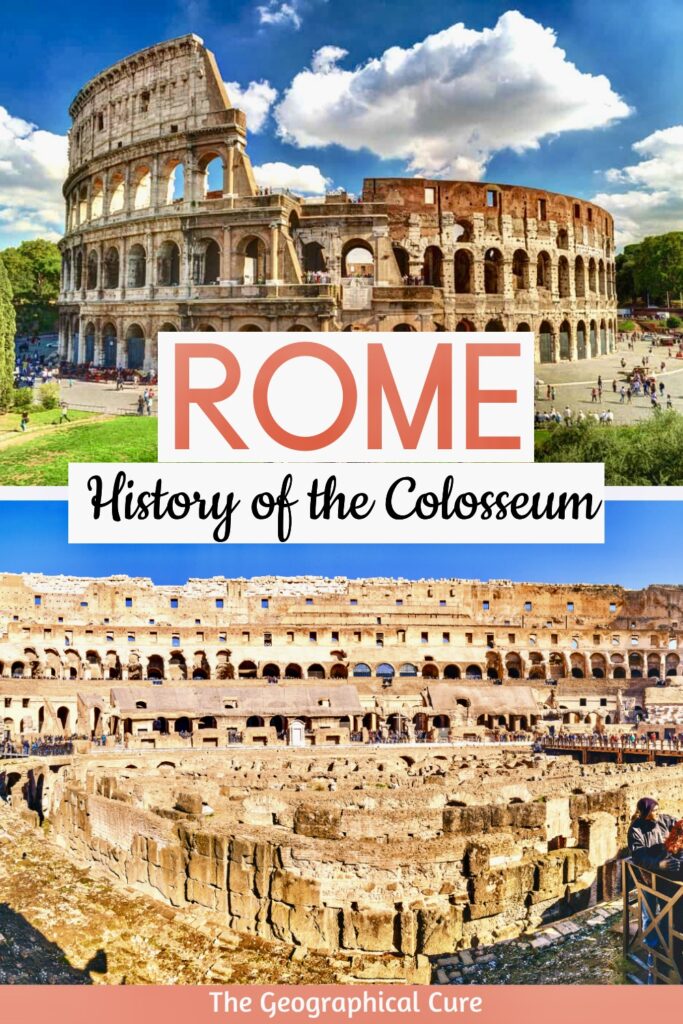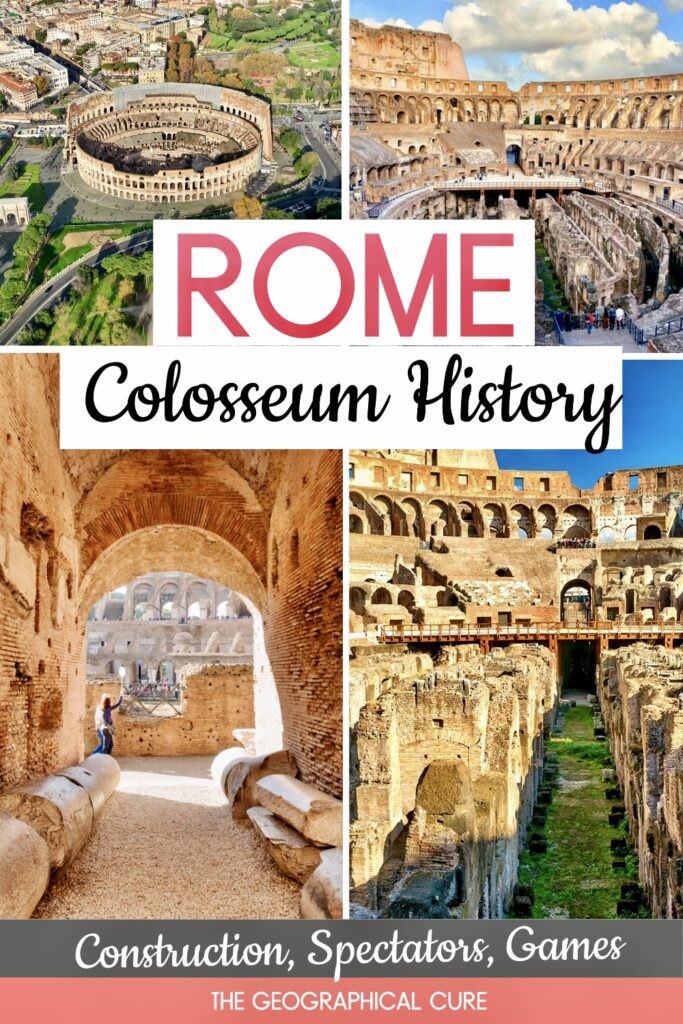The Colosseum stands as a towering testament to Roman ingenuity, its grandeur undimmed after 2,000 years.
It’s not just the largest surviving structure from the Roman world. It’s also the most iconic symbol of the city.
Famed for its gladiatorial battles and public shows, this legendary amphitheater once drew crowds from all corners of the Roman Empire. Despite centuries of neglect and restoration, the Colosseum continues to awe and inspire.
In this blog post, we’ll dive into a brief history of the Colosseum. Get ready to uncover its captivating past and maybe even get inspired for a future visit.
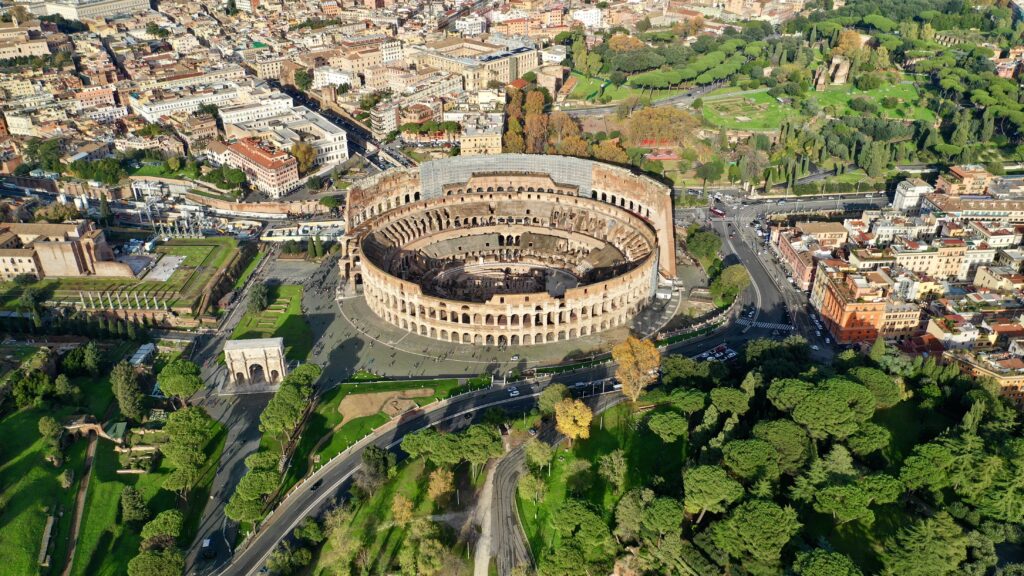
Short History of the Colosseum
1. Construction
From its monarchical foundations in the 8th century BC, to the collapse of the Empire in the 5th century AD, Rome was the city and civilization that dominated the ancient world.
The Colosseum was built under the reign of three emperors, all whom came from the Flavian family. They footed the bill for construction, mostly with booty from the fall of the Temple of Jerusalem.
In 72 AD, Emperor Vespasian began building the Colosseum. His son Titus continued the work.
The Colosseum was finally inaugurated in 80 A.D. under the reign of Emperor Domitian. He later added the hypogeum, or underground basement.
READ: History of Ancient Rome
In other words, this massive amphitheater was built in an incredibly speedy and efficient 8 years, using slave labor of course.
The slaves were specialized. Many were skilled freemasons (except they couldn’t go on strike).
The Colosseum was built with travertine marble, quarried from nearby Tivoli. Travertine was porous and hence a good building material.
It was hauled to Rome on a specially built road. As it was quarried, the blocks of marble were marked so the builders knew exactly where they would go in advance.
The Colosseum was built on the site of Nero’s former Golden House. This wasn’t happenstance.
Vespasian wanted to distance himself from the disgraced Emperor Nero, who had bankrupted Rome with his maniacal spending.
Nero was a notorious ruler credited (possibly wrongly) with crimes like murdering his stepbrother, mother, and several senators. He’s most famous for being suspected of starting the Great Fire of Rome in 64 AD.
Many people believed he caused the fire to clear land for a lavish new palace. The accuracy of this, however, is still debated by historians.
Vespasian sought to shift Roman architecture away from imperial palaces to public buildings to be enjoyed by all citizens. But the shrewd emperor also used the Colosseum as a propaganda tool.
The new arena displayed the power of the Roman state, increased the popularity of the emperors, and promoted a good public image for the Flavians. Perhaps more importantly, it kept the masses happy and entertained.
2. What Did the Colosseum Look Like In Ancient Rome?
The Romans were the best engineers on the planet. The Colosseum was built using cutting edge building techniques.
Romans invented the technique of building with lightweight concrete. This material allowed them to build on a large scale and use design elements like rounded arches.
In its glory days, the Colosseum was vivid, with painted trim and frescoed hallways. Archaeologists have long been aware of this fact. But only recently have they identified the actual colors.
The amphitheater’s walls were likely predominantly red. The travertine blocks had red and white hues. And some sections were blue, likely depicting the sky or a seascape.
There were monumental statues of the Greek and Roman gods in the arches of the middle two stories.
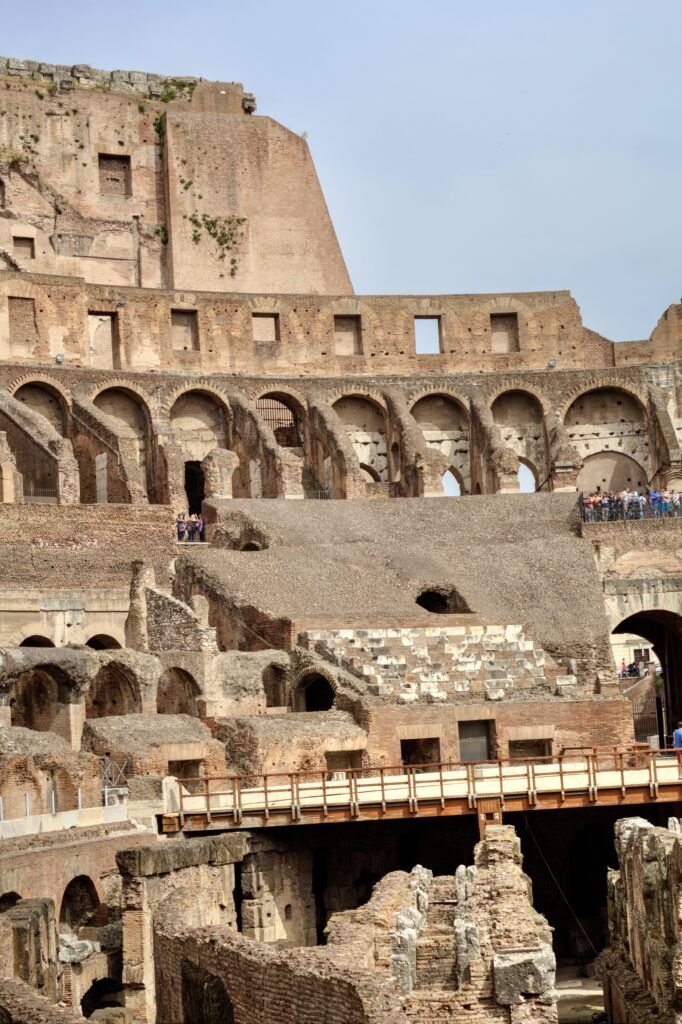
The Colosseum was composed of a series of three arcades, topped by a fourth story or attic. Columns were disposed on three levels from the ground up — Doric, Ionic, and Corinthian — according to the classical order.
The top story had a retractable canvas dome to protect spectators from the heat, rain, and cold.
Outside the entrance stood the Colossus Solis. Previously, the statue stood guard at Nero’s Golden House and was called Colossus Neroni.
After Nero’s memory was officially condemned, images of him were destroyed. But the Flavians decided to repurpose the giant statue.
They added sunbeams to the head, gave it a new face, changed the inscription, and dedicated the image to the sun god instead.
Vespasian moved it to the Colosseum, with the help of 24 elephants.
3. Spectators & Seating
Estimates of crowd capacity in the Colosseum range from 50,000 to almost 90,000. Spectators poured in through 80 arched entrances on the ground level.
They poured in and out through 160 exits, called vomitoria. They were distributed throughout the tiers on various levels.
They allowed for the unruly crowds to make a quick exit. Some say the Colosseum could empty in as little as ten minutes.
There were three tiers of seats: the ima (lowest), the media, and the summa.
Seating was strictly segregated, but free. It was arranged according to social status and profession.
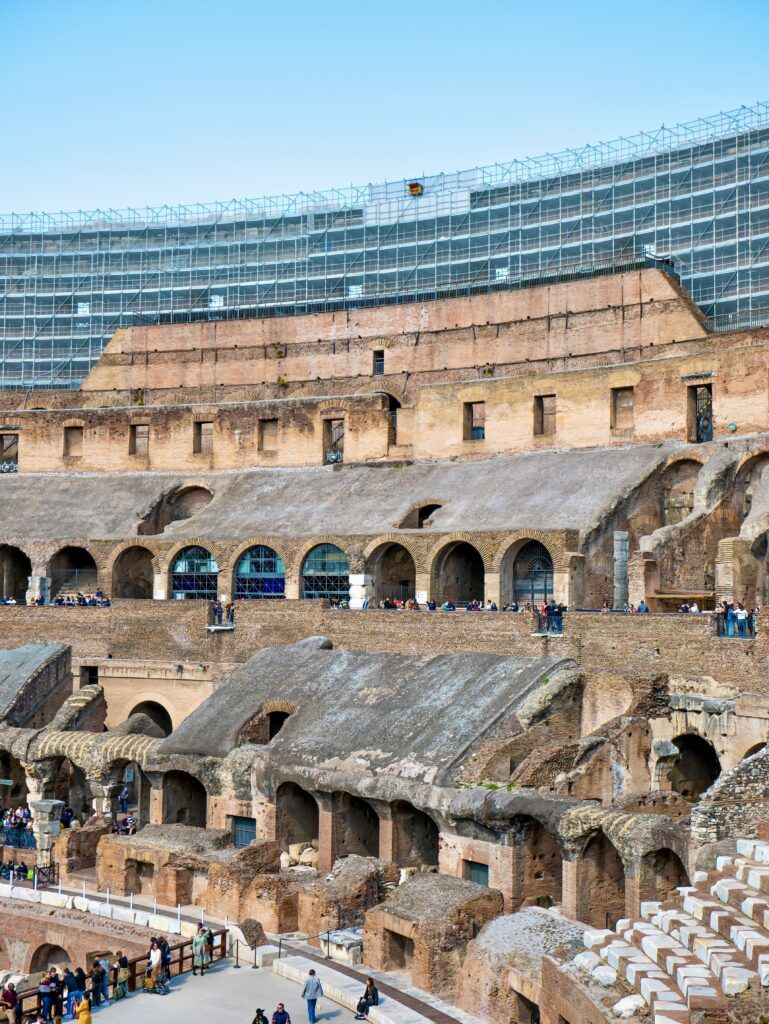
Members of the royal family and the Vestal Virgins had special boxes. The senators, in their red bordered white togas, sat on the same level in the “orchestra” section.
Then came the knights, followed by the plebs (ordinary citizens). Other sections were set aside for soldiers, scribes, students and their tutors, and foreign dignitaries.
A standing room only balcony at the top of the arena was reserved for the least important members of society — women, slaves, and the poor.
Prostitutes, referred to as “lupe” or “she-wolves,” were welcome guests at the Colosseum.
They huddled in the lower level arches, called “fornix” or “forniche.” In fact, that’s the derivation of the modern word “fornicate.”
4. Games Of the Colosseum: Blood Sport
Inside were the jaw dropping spectacles and bloody contests.
The games started in the 3rd century BC. At their peak, there were 162 games in Rome, occurring on public holiday, religious holidays, and imperial holidays.
The games were a form of ancient theater re-creating far flung lands and mythological themes for the masses. There were many variations. The spectacles pitted men against men, men against beasts, and beasts against beasts.
The first people to arrive at the stadium were usually the bookies. They would head to the gladiators’ barracks across the street to get the low down on who was most fit, who was ill, etc.
The actual spectators would arrive around 10:00 am on game day. In the morning, there were warm up acts, animal tricks, and staged hunts. The wild animals that were killed represented Rome itself, as the conqueror of wild lands.
At midday, as more people entered the stadium, there were comic performances. Women dressed as gladiators would battle dwarves.
Sometimes criminals were executed. And there were the animal contests described above.
The main event — the gladiator duels — occurred in the afternoon. Trumpets flared and drums pounded in anticipation. Then, the gladiators marched into the performance arena.
They were the ultimate sports heroes, revered by the masses. Although many of them were slaves or prisoners of war who were sold to gladiator schools, some free men and even aristocrats became gladiators as well.
At the school, they would focus on mastering a particular type of combat. The gladiators were trained to wield a variety of weapons including swords, javelins, and tridents.
Their legendary battles, often ending in death, were the main attraction for every Roman spectator.
Before the games, the gladiators would enter the arena and walk around one full revolution of the ellipse, allowing the spectators to get a good look at them.
They would then stop in front of the imperial box and greet the emperor, though the oft-quoted phrase “we who are about to die for you, salute you” is likely a work of fiction.
After their entrance, the gladiators would retreat to the hypogeum, the locker room and staging area beneath the arena, to prepare for the games.
Each time they fought, the gladiators earned money, with the winners receiving a palm frond and a cash prize. For outstanding performances, a lucky few were awarded a laurel crown.
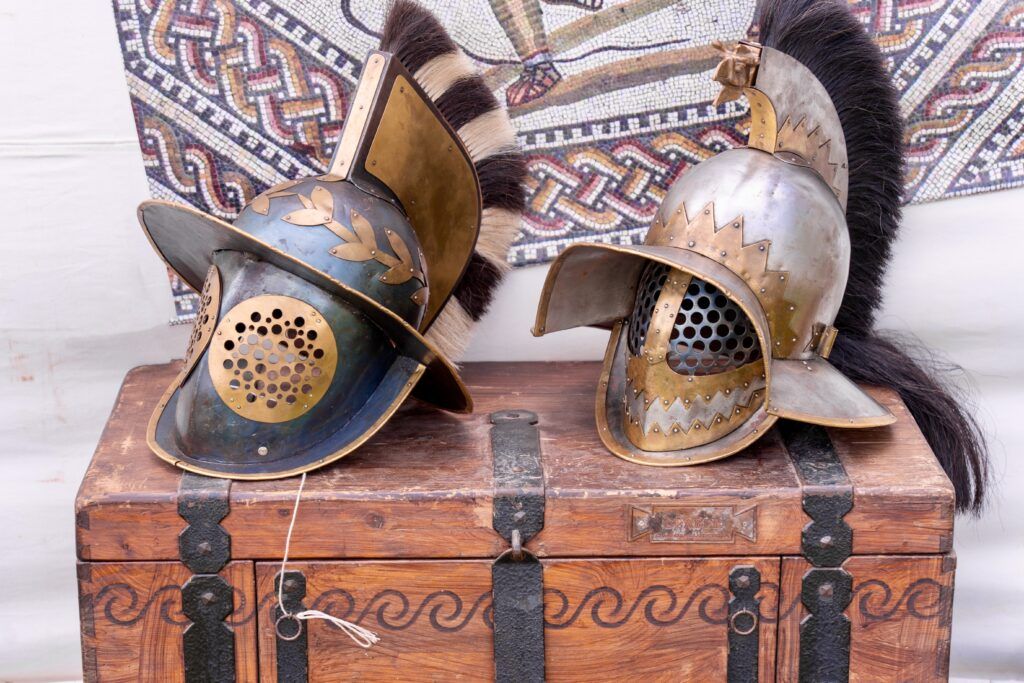
Gladiators in ancient Rome could be set free. This freedom was granted through a process called “manumission.”
A gladiator who had shown exceptional skill, bravery, or had won a significant number of fights could be rewarded with freedom by their master, the crowd, or the emperor. This was often symbolized by the gift of a wooden sword, known as the “rudis.”
Interestingly, even criminals and slaves who survived as gladiators for 3-5 years were set free.
Emperor Commodus even got in on the action. He loved sports and entertainment, and was known for his eccentric behavior, possibly due to mental illness.
He often fought in the Colosseum’s arena, sometimes naked, mostly against exotic animals like lions, ostriches, hippos, elephants, and giraffes.
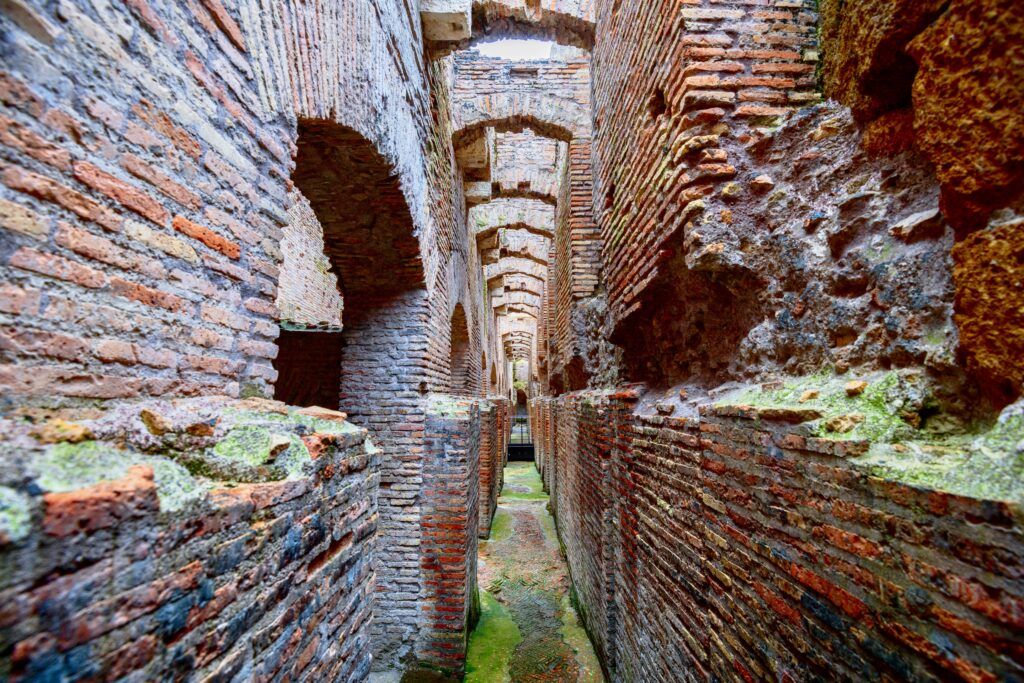
Commodus also faced people in the arena, but let them surrender instead of killing them.
There are also four instances where the Colosseum was flooded to host large-scale naval battles. Ships manned by prisoners fought in the arena, filled with several meters of water.
This type of entertainment, first introduced by Julius Caesar, involved 4,000 rowers and 2,000 fighters on full-sized vessels. These events were extremely popular, sometimes leading to deadly stampedes as spectators fought for the best viewing spots.
Today, the uncovered portion of the arena reveals the corridors and tunnels underneath that the animals and gladiators used to enter the arena.
In the last few years, guided tours to the underground area were introduced. I’ve been on them and they definitely give you a behind-the-scenes look at this ancient form of entertainment.
5. What Happened To The Colosseum?
The Colosseum’s era of games came to an end in 523 AD, closing its doors after nearly five centuries of operation. Over time, it fell into neglect.
The rise of Christianity, with its opposition to the bloody spectacles of the pagan Colosseum, played a significant role in this change. The church preferred citizens to attend sermons rather than games.
In 407 AD, Christian Emperor Honorius banned gladiator contests, though these games continued sporadically until about 435 AD. As the Roman Empire declined, so did the Colosseum’s prominence.
Following the fall of Rome, the Colosseum was repurposed for various uses. It was used as a fortress, for housing, and even as a commercial space with shops.
The Colosseum also suffered from time, natural disasters, and human activity. It was particularly damaged by a major earthquake in 1349, which caused significant parts of it to collapse.
In subsequent years, the Colosseum was stripped of materials. It served as a quarry for marble and travertine blocks.
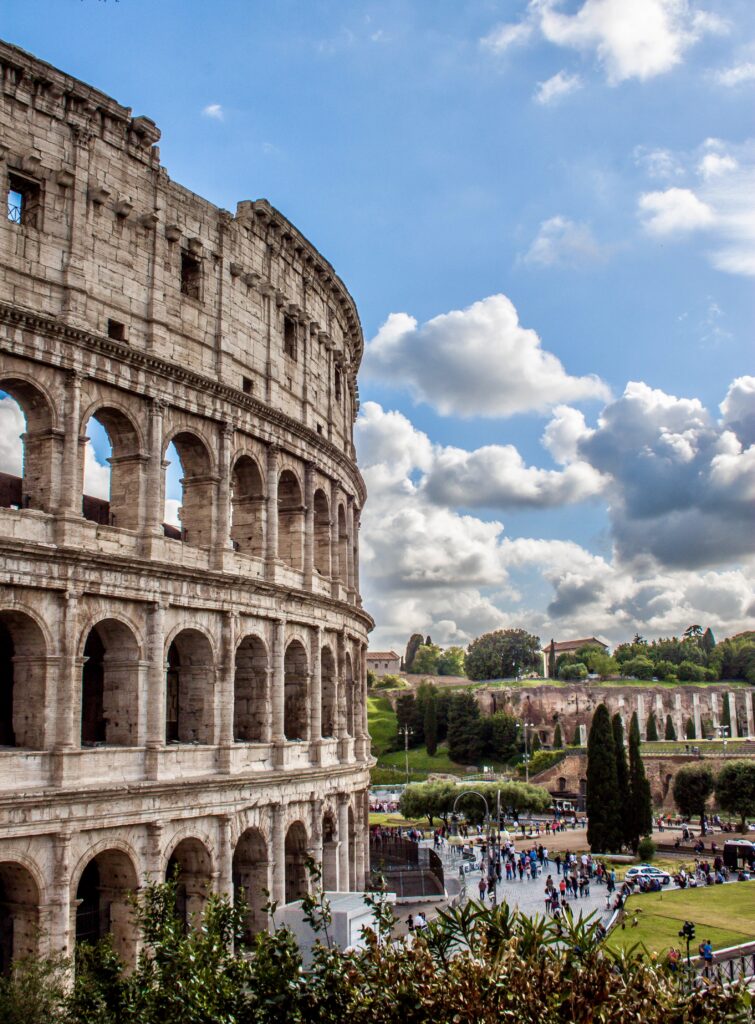
Its decorations and building materials, like many other structures in Rome, were repurposed for other constructions.
Scavengers carried off the stone and statuary in the Middle Ages and the Renaissance for new buildings, including St. Peter’s Basilica.
In the 18th century, steps were finally taken to protect the Colosseum. Pope Benedict XIV designated it a holy place, due to the many Christians that died on the arena floor.
Today, only one third of the Colosseum remains. Still, the Colosseum is relatively well-preserved and the most visited attraction in Rome. I’ve written a guide to the Colosseum.
It tells you everything you can see and gives you essential tips for visiting. The Colosseum is so popular that you simply cannot visit without a timed entry skip the line ticket.
I hope you’ve enjoyed my short history of the Colosseum. You may find the other Rome travel guides helpful:
- 8 ways to spend 1 day in Rome
- 3 day itinerary for Rome
- 4 day itinerary for Rome
- 5 day itinerary for Rome
- Hidden gems in Rome
- Best museums in Rome
- Archaeological sites in Rome
- Guide to the Borghese Gallery
- Guide to Palatine Hill
- Guide to the Roman Forum
- Walking tour of central Rome
Pin it for later.

